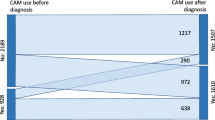Abstract
Traditional Chinese Medicine (TCM) includes both herbal remedies and non-herbal practices. Chinese cancer patients are particularly at high risk for herb–drug interactions. Providers, both primary care physicians and oncologists, frequently do not ask patients about TCM use, which has potentially dangerous consequences. This study describes an assessment of TCM use while undergoing conventional cancer treatment, among a cohort of Chinese immigrant cancer patients in New York City. The Immigrant Health and Cancer Disparities Service at Memorial Sloan–Kettering Cancer Center assists underserved cancer patients through a patient navigation program, the Cancer Portal Project. Six questions related to TCM are included in the existing Portal Needs Assessment Intake. Mandarin- or Cantonese-speaking Portal patients enrolled between January 2010 and May 2012 were surveyed. One hundred nine Chinese-speaking patients were enrolled in the Portal Project during the study period. Forty-six completed the TCM questions. Ninety-six percent preferred to speak Mandarin, Cantonese, or Fujianese in the healthcare setting. Thirty-nine percent (n = 18) of the 46 participants reported using TCM since being diagnosed with cancer. Nearly all (n = 16) who used TCM reported using herbal medicines. Ten TCM users did not describe sharing their use with Western doctors. Eight (44 %) of TCM users reported concurrently using TCM and conventional cancer treatment. Larger scale studies should further explore the concurrent use of TCM and conventional cancer treatment in this unique population. Future research should also address patient–provider communication related to the concurrent use of TCM and cancer treatment. This is also an important area of education for both patients and providers.
Similar content being viewed by others
References
Su D, Li L (2011) Trends in the use of complementary and alternative medicine in the United States: 2002–2007. J Health Care Poor Underserved 22(1):296–310. doi:10.1353/hpu.2011.0002
Ferro MA, Leis A, Doll R, Chiu L, Chung M, Barroetavena MC (2007) The impact of acculturation on the use of traditional Chinese medicine in newly diagnosed Chinese cancer patients. Support Care Cancer 15(8):985–992. doi:10.1007/s00520-007-0285-0
Chiu J, Yau T, Epstein RJ (2009) Complications of traditional Chinese/herbal medicines (TCM)—a guide for perplexed oncologists and other cancer caregivers. Support Care Cancer 17(3):231–240. doi:10.1007/s00520-008-0526-x
Abdullah AS, Lau Y, Chow LW (2003) Pattern of alternative medicine usage among the Chinese breast cancer patients: implication for service integration. Am J Chin Med 31(4):649–658
Liu JM, Chu HC, Chin YH, Chen YM, Hsieh RK, Chiou TJ, Whang-Peng J (1997) Cross sectional study of use of alternative medicines in Chinese cancer patients. Jpn J Clin Oncol 27(1):37–41
Deng G, Cassileth BR, Yeung KS (2004) Complementary therapies for cancer-related symptoms. J Support Oncol 2:419–426
Gerber B, Scholz C, Reimer T, Briese V, Janni W (2006) Complementary and alternative therapeutic approaches in patients with early breast cancer: a systematic review. Breast Cancer Res Treat 95(3):199–209. doi:10.1007/s10549-005-9005-y
Maskarinec G, Shumay DM, Kakai H, Gotay CC (2000) Ethnic differences in complementary and alternative medicine use among cancer patients. J Altern Complement Med 6(6):531–538
Lee MM, Lin SS, Wrensch MR, Adler SR, Eisenberg D (2000) Alternative therapies used by women with breast cancer in four ethnic populations. J Natl Cancer Inst 92(1):42–47
Dhingra L, Lam K, Homel P, Chen J, Chang VT, Zhou J, Chan S, Lam WL, Portenoy R (2011) Pain in underserved community-dwelling Chinese American cancer patients: demographic and medical correlates. Oncologist 16(4):523–533. doi:10.1634/theoncologist.2010-0330
Saw JT, Bahari MB, Ang HH, Lim YH (2006) Potential drug–herb interaction with antiplatelet/anticoagulant drugs. Complement Ther Clin Pract 12(4):236–241. doi:10.1016/j.ctcp.2006.06.002
Yang AK, He SM, Liu L, Liu JP, Wei MQ, Zhou SF (2010) Herbal interactions with anticancer drugs: mechanistic and clinical considerations. Curr Med Chem 17(16):1635–1678
American Cancer Society. Guide to Cancer Drugs. 2012. http://www.cancer.org/treatment/treatmentsandsideeffects/guidetocancerdrugs/docetaxel?url=http%3A www.cancer.org/treatment/treatmentsandsideeffects/guidetocancerdrugs/docetaxel. Accessed May 2013
Mathijssen RH, Verweij J, de Bruijn P, Loos WJ, Sparreboom A (2002) Effects of St John's wort on irinotecan metabolism. J Natl Cancer Inst 94(16):1247–1249
Frye RF, Fitzgerald SM, Lagattuta TF, Hruska MW, Egorin MJ (2004) Effect of St John's wort on imatinib mesylate pharmacokinetics. Clin Pharmacol Ther 76(4):323–329. doi:10.1016/j.clpt.2004.06.007
Cox MC, Low J, Lee J, Walshe J, Denduluri N, Berman A, Permenter MG et al (2006) Influence of Garlic (Allium sativum) on the pharmacokinetics of docetaxel. Clin Cancer Res 12(15):4636–4640. doi:10.1158/1078-0432.ccr-06-0388
Meijerman I, Beijnen JH, Schellens JH (2006) Herb–drug interactions in oncology: focus on mechanisms of induction. Oncologist 11(7):742–752. doi:10.1634/theoncologist.11-7-742
Yap KY, See CS, Chan A (2010) Clinically relevant chemotherapy interactions with complementary and alternative medicines in patients with cancer. Recent Pat Food Nutr Agric 2(1):12–55
McCracken M, Olsen M, Chen MS Jr, Jemal A, Thun M, Cokkinides V, Deapen D, Ward E (2007) Cancer incidence, mortality, and associated risk factors among Asian Americans of Chinese, Filipino, Vietnamese, Korean, and Japanese ethnicities. CA Cancer J Clin 57(4):190–205
Wu AP, Burke A, LeBaron S (2007) Use of traditional medicine by immigrant Chinese patients. Fam Med 39(3):195–200
Klabunde CN, Ambs A, Keating NL, He Y, Doucette WR, Tisnado D, Clauser S, Kahn KL (2009) The role of primary care physicians in cancer care. J Gen Intern Med 24(9):1029–1036. doi:10.1007/s11606-009-1058-x
Gany F, Ramirez J, Nierodzick ML, McNish T, Lobach I, Leng J (2011) Cancer portal project: a multidisciplinary approach to cancer care among Hispanic patients. J Oncol Pract 7(1):31–38. doi:10.1200/JOP.2010.000036
Leng J, Lee T, Sarpel U, Lau J, Li Y, Cheng C, Chang MD, Gany F (2012) Identifying the informational and psychosocial needs of Chinese immigrant cancer patients: a focus group study. Support Care Cancer 20(12):3221–3229. doi:10.1007/s00520-012-1464-1
Acknowledgments
The authors gratefully acknowledge Michell Chang-Qui, Maria Xia, and Mei Hsuan Chen for their assistance with data collection and data entry for this study. This study was conducted with funding from NCI grant #U54-13778804-S2.
Conflict of Interest
None of the authors have any conflicts of interest
Author information
Authors and Affiliations
Corresponding author
Rights and permissions
About this article
Cite this article
Leng, J.C.F., Gany, F. Traditional Chinese Medicine Use among Chinese Immigrant Cancer Patients. J Canc Educ 29, 56–61 (2014). https://doi.org/10.1007/s13187-013-0542-5
Published:
Issue Date:
DOI: https://doi.org/10.1007/s13187-013-0542-5



